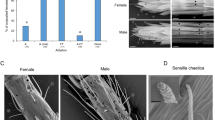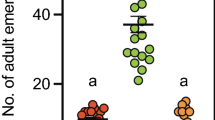Abstract
To select a host and to oviposit in it, parasitic Hymenoptera may require visual, olfactory and/or chemotactile stimuli1–3. Some species can recognize a host by piercing it with the ovipositor4–6, but nothing is known of the stimuli (supposedly chemical) that elicit such recognition. In the wild the North American ichneumonid, Itoplectis conquisitor (Say), attacks host pupae in cocoons, hollow stems or rolled leaves. In the laboratory, females are attracted to artificial host shelters, such as paper tubes examining them with the antennae and probing them with the ovipositor. If pupae of various Lepidoptera are placed in such tubes eggs are deposited in them. In similar conditions, we have found that eggs are laid in pupal haemolymph of the greater wax moth, Galleria mellonella L., but not in distilled water, saline solution, egg albumin, chicken blood or a mixture of amino-acids. Apparently females can recognize the contents of tubes (for the purpose of oviposition) by probing with the ovipositor. Here we report the isolation of a physiologically active component of G. mellonella haemolymph that induces oviposition by I. conquisitor. To our knowledge this is the first demonstration of a chemical that induces oviposition by a parasitic insect.
This is a preview of subscription content, access via your institution
Access options
Subscribe to this journal
Receive 51 print issues and online access
$199.00 per year
only $3.90 per issue
Buy this article
- Purchase on Springer Link
- Instant access to full article PDF
Prices may be subject to local taxes which are calculated during checkout
Similar content being viewed by others
References
Arthur, A. P., Canad. Entomol., 98, 213 (1966).
Fisher, R. C., Canad. J. Zool., 37, 429 (1959).
Ullyett, G. C., Proc. Roy. Soc., B, 120, 253 (1936).
Dethier, V. G., J. Exp. Zool., 105, 199 (1947).
Salt, G., Proc. Roy. Soc., B, 122, 57 (1937).
Jackson, D. J., Trans. Roy. Entomol. Soc., 118, (2), 23 (1966).
Arthur, A. P., Canad. Entomol., 94, 337 (1962).
Rosen, H., Arch. Biochem. Biophys., 67, 10 (1957).
Lowry, O. H., Rosebrough, N. J., Farr, A. L., and Randall, R. J., J. Biol. Chem., 193, 265 (1951).
Author information
Authors and Affiliations
Rights and permissions
About this article
Cite this article
ARTHUR, A., HEGDEKAR, B. & ROLLINS, L. Component of the Host Haemolymph that induces Oviposition in a Parasitic Insect. Nature 223, 966–967 (1969). https://doi.org/10.1038/223966a0
Received:
Issue Date:
DOI: https://doi.org/10.1038/223966a0
This article is cited by
-
10.1007/BF00304647
CrossRef Listing of Deleted DOIs (2011)
-
Host egg kairomones essential for egg-larval parasitoid,Ascogaster reticulatus Watanabe (Hymenoptera: Braconidae)
Journal of Chemical Ecology (1989)
-
Host egg kairomones essential for egg-larval parasitoid,Ascogaster reticulatus watanabe (Hymenoptera: Braconidae)
Journal of Chemical Ecology (1988)
-
Changes in the Composition of Host Haemolymph after Attack by an Insect Parasitoid
Nature (1970)
Comments
By submitting a comment you agree to abide by our Terms and Community Guidelines. If you find something abusive or that does not comply with our terms or guidelines please flag it as inappropriate.



